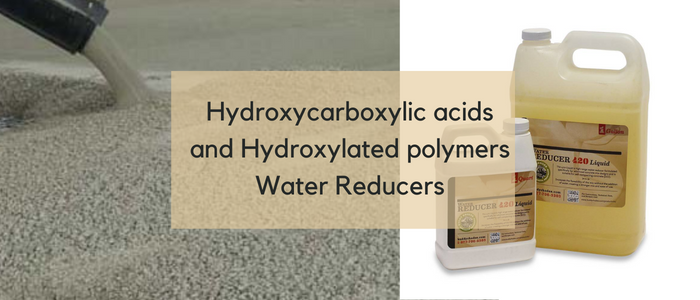Hydroxycarboxylic acids and Hydroxylated polymers Water Reducers as Concrete admixtures
What are water reducing admixtures for concrete?
Water reducers ( one of the concrete admixtures) are a type of additive that are added to concrete during the mixing process. Examples include hydroxycarboxylic acids and hydroxylated polymers. Without affecting the workability or mechanical strength of concrete, water reducers can lower the water content by 12 to 30 percent (which we usually express in terms of compressive strength). Superplasticizers, plasticizers, and high-range water reducers are additional terminology for water reducers (HRWR).
Types of Water-reducing Admixtures
Water-reducing admixtures come in many different varieties. These admixtures are known by a variety of names and classifications used by manufacturing businesses, including water-proofers, densifiers, workability aids, etc.
According to their chemical makeup (as shown in Table 1), water-reducers may generally be divided into three groups: lignosulfonates, hydroxycarboxylic acid, and hydroxylated polymers.

This is second post on the water-reducers admixtures. The first post (click here) dealt with lignosulfonate water-reducers. Here, the second post will be on the hydroxycarboxylic acid and hydroxylated polymers admixtures,
Hydroxycarboxylic Acids Water Reducers for concrete
These organic compounds, as their name suggests, include both hydroxyl and carboxyl groups in their molecules.
Sodium salt is most typically used salt in the hydroxycarboxylic acids admixtures, although occasionally the materials are found as salts of ammonia or triethanolamine.
They are produced from pure raw material feedstocks, by either chemical or biochemical means and, therefore, are of high and consistent purity. Indeed, the primary use of the materials is often in foodstuffs or pharmaceuticals.
Since all sodium salts are very soluble and have low freezing points, it is unlikely that they will solidify over the winter.
The sorts and formulas of the components that have reportedly been used in the creation of this kind of water-reducing admixture are shown in Figure 1. However, only the salts of gluconic and heptonic acids are used on a large basis in formulations.

Depending on the planned function in concrete, roughly 30 percent solutions of the salts would typically be utilised with additions of other chemical types. Thus, when the salts are present alone, they can create water-reducing admixtures that are retarding at higher doses and producing typical water-reducing admixtures at lower dosages.
Small amounts can be blended with calcium chloride to produce accelerating water-reducing admixtures which are almost colorless, sediment-free solutions and, in a similar manner to lignosulfonates, air-entraining agents can be added to form the air-entraining water-reducing admixtures which may or may not be retarding, depending on the amount of hydroxycarboxylic acid salt present in the formulation.
Hydroxylated Polymers Concrete Admixtures
The hydroxylated polymers are derived from naturally occurring polysaccharides, such as corn starch, by partial hydrolysis to form lower-molecular-weight polymers containing from 3 to 25 glycoside units (Figure 2).
Unlike the monosaccharide glucose, these materials are stable under the alkaline conditions of a cement containing composition and behave as efficient water-reducing agents. They do slow down the concrete into which they are integrated, however this may be remedied by adding modest amounts of triethanolamine or calcium chloride.
The bulk of commercially available products fall into one of the three types of key components outlined above for the creation of water-reducing admixtures, while insitol, polyacrylamide, polyacrylic acids, and polyglycerol may occasionally be used.
Uses of Water-reducers in Concrete
- Superplasticizer doses are generally 0.25 percent, which can cause water decreases in cement content of up to 9 to 12 percent (0.20-0.30 percent ). When compared to the reference concrete, the concrete’s strength increased by 15-20% when used in the recommended dosage. After three days, strength increased by 20 to 30 percent, then by 15 to 20 percent after seven days, and by the same percentage after 28 days.
- Concrete may flow more freely without changing the water, making it simpler to work with (i.e. increasing workability).
- In its usual form, concrete mixed with this agent may cause delays in the ultimate setting time of the concrete by more than three hours and the peak heat of hydration by more than five hours.
Forms of water-reducers
Reducers come in either powder or liquid format.
